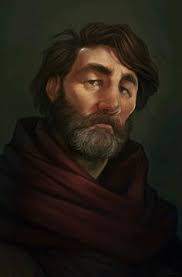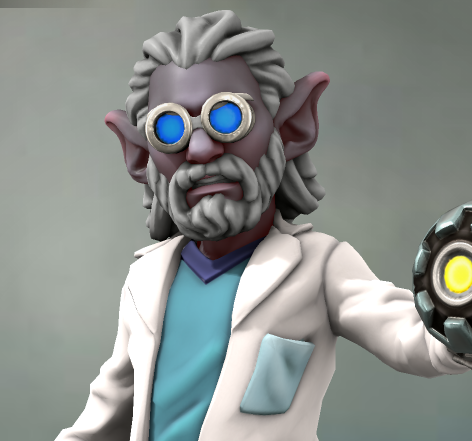The Redflow River
Its upper banks touch the borders of the Firsthome lands as well as the lands claimed by the folk around their Ironhill Delve, while its lower course flows through the fertile farmlands of the First Kingdom of Humankind. Three races of the Folk therefore rely on the Redflow River not only for trade amongst themselves, but also for access to the sea and the rest of the world beyond.
Cry Me a River
According to the Duagan history of the Ironhills Delve, it was only after the Duagan folk began to establish the delve that a stream burst forth from springs on the mountain's western face. They named this new river, the Tears of the Mountain, claiming that the mountain itself was weeping in joy at being deemed worthy to be a new home for the Duagan folk. This new river flowed down into a river that already existed to the South, but from that point on, the Duagans considered the western mountain springs to be the source of the river that ultimately reached to the sea, and the branch that joined it from the east was considered to be the tributary.Geography
Source
The Redflow rises deep within the mountain which houses the Ironhill Delve of the Duagan folk, which they call Ironhome Spire. The peak of this mountain is covered year round by snow and glacier. The runoff from the peak falls through great crevasses into the interior of the mountain itself and converge into a single mighty stream that exits the base of the mountain's western face. The huge cavern at this point is used as a trading port by the Delve.Terminus
At its western end, the Redflow spreads into a delta as it empties into the Inner Sea. The First Kingdom city of Eastkeep is built on and around this delta, thus encompassing the river's exit to the sea. Eastkeep's port is thus the gateway linking the trade that flows on the river with the rest of the world.Tributaries
Numerous tributaries flow into the Redflow from their sources in the Iron Mountains to the north. Two notable tributaries enter the Redflow from the south as well - one from the central part of the Iron Mountain range joins the river near its eastern source; another joins the river after draining the northern parts of the grassy plains that mark the edge of the Alev Firsthome region.Navigability
The Redflow is navigable by smaller trade barges and personal craft along its full course from the Ironhills Delve to Eastkeep. Many of the tributaries are similarly navigable at least halfway toward their sources. Not all of these courses are naturally navigable, but the Duagan skills with earth and stone have been used to carve channels through the shallower stretches to preserve shipping viability.From the Duagan city of Irongate to the sea, the river is sufficiently broad and deep to support much larger shipping as well. Occasional dredging of winter-fed silt deposits is required, but the Duagans and Humans work in concert to ensure shipping remains viable.
Important Cities and Towns
In addition to Eastkeep at the terminus and the Ironhill Delve at the source, there are a number of other settlements along the Redflow that warrant mention. They are listed in the order encountered by a traveler from the Delve to the sea:Ecology
The fauna of the Redflow is typical of what one would expect in any river. Land creatures living nearby rely on the river as a water source; some like the bears that occasionally follow a tributary out of the foothills find food in the river as well.Many species of fish can be found in the river, from common trout to the beast called the fishgator by the folk along the river. This terror, found in the downstream regions of the river, can reach 8 ft (2.5m) in length. Its 2 ft (60cm) toothy jaws and carnivorous appetite make it hazardous to be in the water near one.
History
The Redflow has been an important trade route for as long as the Duagan folk have occupied the Ironhills Delve. But the real historical importance of the river lies in the part it played in the struggles during the Great Strife. The god-war saw armies of the Dark gods pouring out of the Iron Mountains and along the river's course in an effort to overrun the First Kingdom of Humanity. Great battles were fought in the gap between the Elvenring and Iron Mountains. The lands around Borderkeep and Battlecrux are the sites of clashes where the humans stood their ground and defeated their foes. The Humans erected fortifications there; the ruins of many of these can be seen today amid the hilly fields and grasslands. Some folk maintain these are still haunted by the fallen from both sides of the conflict.Trade Along the River
Goods Being Moved
A variety of trade goods from all over Cartyrion can be found in the rivercraft of the merchants traveling up and down the river, but there are four types of goods that make up the vast majority of river trade:Vessels Being Used
The Redflow, especially the segments downriver from Irongate, is a rather busy river for trade. Vessels in a wide variety of shapes and sizes ply its waters moving trade goods in both directions. While some of these vessels, such as the common canoes and rafts, will be familiar to anyone experienced in river trade around the world, some are unique to the Redflow.The Redflow Smoothback
This is a variety of freshwater turtle native to the Redflow. They have been bred and domesticated for use as draft animals by the folk along the river for centuries. These are large creatures, often measuring over 6.5ft (2m) in length from beak to tail and weighing several hundred pounds.Unlike most freshwater turtle species, their limbs are flipper-like rather than ending in clawed feet, making them resemble their deep-ocean cousins more than other common land or freshwater species. These flippers grant them sustained swimming at speeds of up to 10mph (16kph), with short bursts of speed at twice that rate. Under harness, their speeds are diminished somewhat by the weight they are pulling, but a properly sized team is more than enough to overcome the 3mph (5kph) currents of the river. Unique to the Redflow until recently, though, are the craft referred to as river wagons (which carry cargo) and river coaches (which carry passengers). These can be found along the entire length of the Redflow from Eastkeep to the Ironhills Delve.
What makes these vessels unique is their method of propulsion: they are pulled by turtles. The smallest craft may have a single turtle in harness, while larger barge-like craft may rely on teams of two, four, or even eight creatures to bring them upriver against the current.
The Redflow Riverfolk
The folk who make their living on the Redflow comprise a culture unique to the river - a culture that spans races. These folk have formed a community that is found along the entire length of the river, with most of those whose occupation is the transport of goods up and down the flow knowing almost every else. Few of these folk have permanent homes; most of the river wagons will include a small shelter where driver and family reside.The Dwalev Swimship
Another vessel unique to the Redflow is a craft devised by an inventive named Glenivart Smedilboop called the Swimship. This vessel makes use of the type of engineering that only one of that race would consider.A complex - and to most confounding - collection of gears, pistons, pulleys, cables, and levers connect a steam-generating boiler to a long set of articulated arms - each 20' (6m) long - which propel a barge-like boat through the water using the same motion as a swimmer doing the breast stroke. When fully up to speed, a swimship is capable of outpacing the turtle-drawn craft on the river.
The vessels have a bad reputation among the non-Dwalev river folk. They are extremely difficult to steer properly, hence groundings along the shores are common occurrences. Furthermore, their loud steam hisses and the sometimes erratic splashing of the arms often spooks teams of smoothbacks nearby, thus wreaking havoc among the rest of the traffic on the river.
Fortunately for the rest of the merchants and riverfolk on the waters, only four of these craft are currently operational.
Overnight camps appear along the river every evening. These temporary villages allow the riverfolk to socialize, gamble their coin on games of chance, or even celebrate special events such as life-bondings. Craft that operate as portable taverns move up and down the river by day, setting up for an evening of trade at one of the overnight camps. Craftsmen work out of floating shops that also become parts of these villages, offering repair and maintenance of vessels. Floating "general stores", clothing shops, and even bakeries and restaurants join these "night villages", as they are called, each evening to allow the Riverfolk the opportunities to shop and mingle just as the residents of any land-based village would do.
In the mornings, the folk return to their barges and these villages disappear, only to be reconstituted the following evening with different mixes of residents.










Wow, Bob ... this is jam-packed with info. Well done!
My World
Thanks... and thanks for taking the time to comment! Your Darkwater was no slouch either as far as info was concerned.
The Perseus Arm - A new, alternative setting for fans of Traveller in any of its variations.
Laurels & Loot is a new, lightweight TTRPG rules system that hearkens back to the early days.